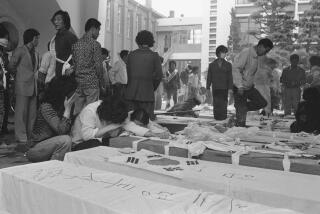Former Foes Building New Bridges on the River Kwai
- Share via
KANCHANABURI, Thailand — Ex-British soldier Eric Lomax returned to the infamous Bridge on the River Kwai to pay homage to all his fellow POWs who suffered here at the hands of the Japanese.
He came with a surprising companion--the Japanese interrogator whose face and voice have haunted him since torture sessions during the building of the “Death Railway” in World War II.
“Time heals all wounds, but there is no cure for torture,” Lomax said.
Nevertheless, he is now friends with Takashi Nagase, who participated in brutal interrogations of Lomax all those years ago. They have joined in the common cause of promoting reconciliation among the veterans of both sides.
It was Nagase’s 99th trip here in 35 years to atone for his wartime activities, a visit recorded by the Japanese television network NHK for a documentary on the former military policeman’s charity work.
Nagase, who like Lomax is 80, said that when the war ended he was sure he would be hanged as a war criminal for his role in interrogating Lomax and three other British prisoners suspected of having a radio and map. Two of the prisoners were beaten to death and dumped headfirst into a latrine. Lomax was beaten with ax handles and almost drowned from water torture as Nagase hissed at him, “Lomax, soon you will die.” He still has nightmares and flashbacks about it.
Nagase wasn’t charged by the Allies, however. After helping pinpoint graves of POWs who had died, he was sent back to Japan.
But guilt over his deeds haunted him. He eventually founded several charities in Kanchanaburi for local Thais, including scholarship funds and medical projects, as penance for Japanese atrocities.
During the Japanese occupation, 60,000 captured Allied soldiers and 200,000 Asian slave laborers were forced to build a 257-mile railway across Thailand and Burma to supply Japan’s war effort.
More than 120,000 died of starvation, overwork, beatings and disease during the 17 months it took to build. In February 1945, British and American bombers destroyed the River Kwai bridge.
The prisoners’ ordeal was portrayed by Pierre Boulle’s book “The Bridge on the River Kwai” and the Academy Award-winning movie of the same name.
Both Lomax, who lives in Berwick-upon-Tweed, England, and Nagase, who lives in Kurashiki, Japan, wrote books about their individual roads seeking reconciliation, which led to their first meeting in 1995.
“Meeting Nagase, the man I wanted to kill, . . . has enabled me to free myself from the hate and the horror of the Death Railway,” Lomax said.
During their time together for the NHK documentary, they visited the bridge as well as “Hellfire Pass,” a stretch of the rail line where torturous working conditions and malaria caused many of the POW deaths.
“For Eric Lomax to forgive me for what I did to him means I can go to the grave with a clear conscience,” Nagase said.
More to Read
Sign up for Essential California
The most important California stories and recommendations in your inbox every morning.
You may occasionally receive promotional content from the Los Angeles Times.













